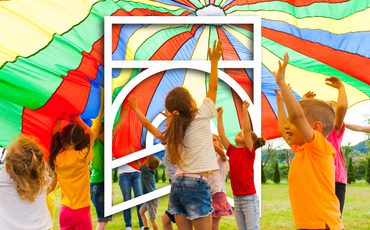
Learning Names
with Dr. Phil Kearney
Connecting with individuals is at the heart of coaching, and the first step in connecting is often learning names.
It is the start of a new season, and 15-20 children aged 7-8 years old are arriving for their athletics experience. While a few children are staying with me for another year, the majority have moved on into another group and so I have a lot of new names to learn. As the children come from 5-6 different schools, the children have a lot of new names to learn also. Unfortunately, learning names is not something that comes easily to me. I need to find a way around that problem however, because I believe connections are important and that names help me forge a connection. So how do I do it?
The first method I have learned is to design games where names play a central role. The name game for instance. We play the name game with groups of 6-10 children using a circle of hoola hoops. Each chid stands in a single hoola hoop. The game starts with the coach call out his/her name and a movement. For example:
“Phil, jump”
Everybody repeats both the name and the action.
Then we move onto the first child, who says their name (Ann) and picks an action to add to the list (press up).
All together: “Phil, jump, Ann, press up”.
On to the next name and activity.
And inevitably, you hit a snag. Barry doesn’t know what movement to pick.
“That’s okBarry”, you say. “While Barry has a think about what movement he wants to make, I want you all to think about what movement you are going to pick. It can be a jump, or a balance, or something using the hoola hoop [dropping lots of hints for Barry and everyone else]. Think of a couple of ideas just in case somebody else thinks of the same thing as you.” By that stage, Barry has picked a star jump, and we’re ready to continue:
“All together: Phil, jump; Ann, press up; Barry, star jump”
Cáit is up next, and her suggestion is a little bit vague: lie down. That can be interpreted in lots of different ways, but that’s a good opportunity for you. Can you adapt the movement into something slightly different to what the children have already picked, so that they are creating a multi-dimensional set of exercises?
“Do you mean like this Cáit?” you ask, squatting down and rolling onto your back in the dead bug position. Either Cáit will say yes, and you will have extended the range of movements that the children perform, or Cáit will say no (dealing with 7 year olds, perhaps “not like that, silly, like this!” is more likely). If Cáit picks her own movement, then you are reinforcing her control over some of the content of the session; research has consistently shown benefits to providing children with such control.
Once every child has contributed a movement, you can mix it up a little. Start by going backwards through the sequence. If the children can manage that, mix it up. Walk around the outside of the circle calling out random names, and the children have to perform the actions. Take a short break by having children standing opposite each other race around the circle (how fast can you get back to your hoop?) before returning to the name game to see how many of the names stuck (for you and for the children). Such testing after a short break is a useful tool to enhance learning.
Straight after the name game, I like to go into something a bit more chaotic. A game of tag, for example, where there is no order to the sequence in which I will see the children. Dealing with a random sequence of faces is called interleaved practice, and while it typically features a few more pauses as you struggle to recall names (“Is that Cara or Clara?), interleaved practice has also been shown to improve later recall.
Another game we use is a variation on a simple numbers game. Children run, skip, hop, gallop or sidestep around the inside of a small rectangle. When the coach calls a number (e.g., 4), children must arrange themselves into groups of 4 and balance on one leg. But that’s not the end of the game. To gain the point, the group must both maintain their balance and, when the coach points at one individual in the group, that person must be able to name all of his/her groupmates. It is important to only check on a couple of groups per pause, so that the pace of the game does not drop too low. The addition of names is a neat way to get a broader benefit out of a game primarily designed to enhance movement skills. Can you think of any other activities where children reporting their team mates’ names could be incorporated into the activity?
Immediately after the session, I can often be seen sitting quietly in my car for a few minutes. I use this time to engage in another memory exercise. I write down or mentally run through a list of all the names I can remember from the session. With each name, I image the face of the child. I might also add in any details that the child mentioned during the session to make the image more memorable (e.g., having been told by Hannah, on multiple occasions during the session, that she owns two rabbits, I might picture two rabbits sitting on Hannah’s shoulders). Our memory seems predisposed to remember images (think: ‘I know that person’s face; I just cannot put a name to it’), and we can use this predisposition to accelerate our learning. Spending 2-3 minutes running through names and images is the first step in quickly learning names.
Here is where the name game has another advantage. The circle of hoola hoops can serve as a kind of ‘memory palace’. Imagine the game again: ‘Phil, jump, Ann, press up, Barry, star jump’ and so on. The specific memory should function as an aid to your memory when recalling the names.
While practice immediately after the session is useful, it is only a first step. Without further practice, you may find yourself needing to be reminded of names when you return for the next session. So, before you pull away from the carpark, set your alarm for about the same time the following day. When that alarm goes off, repeat the exercise. Call up from memory the names and faces of the children from the session. When you finish that, set another alarm for two days time. This process of trying to recall information over gradually increasing intervals is called spaced practice, and is another proven method of improving your memory.
Connecting with individuals is at the heart of coaching. Learning a child’s name is often the first step in building that connection. Especially when dealing with large groups of children, learning names is not easy. Designing games that include names, testing yourself, interleaving practice, using imagery and spacing practice are all techniques that can help you learn names and establish that connection.
Contributor:

Dr. Phil Kearney
Phil is the Course Director for the MSc Applied Sports Coaching at the University of Limerick, Ireland. He received his PhD from the University of Limerick in 2009, investigating how applying skill acquisition principles could accelerate the development of children’s fundamental movement skills. He then taught at the University of Chichester from 2009-2017, where he was Programme Coordinator for the BSc Sport Science & Coaching. Phil returned to the University of Limerick in 2017. A Fellow of the Higher Education Authority, Phil’s research and teaching focus is on skill acquisition and youth sport, particularly in the context of developing track and field athletes. Phil is a co-founder of Movement and Skill Acquisition Ireland and holds the Athletics Coach qualification from UK Athletics
Comments
Related Pages


